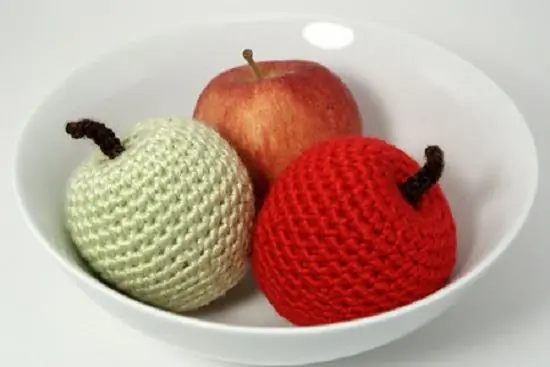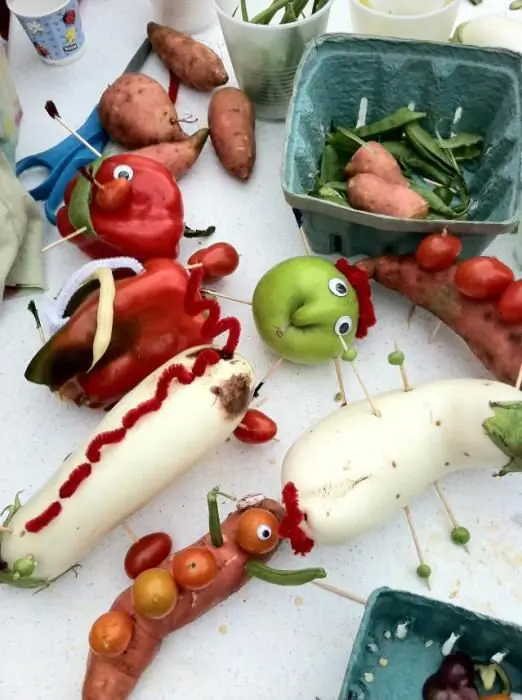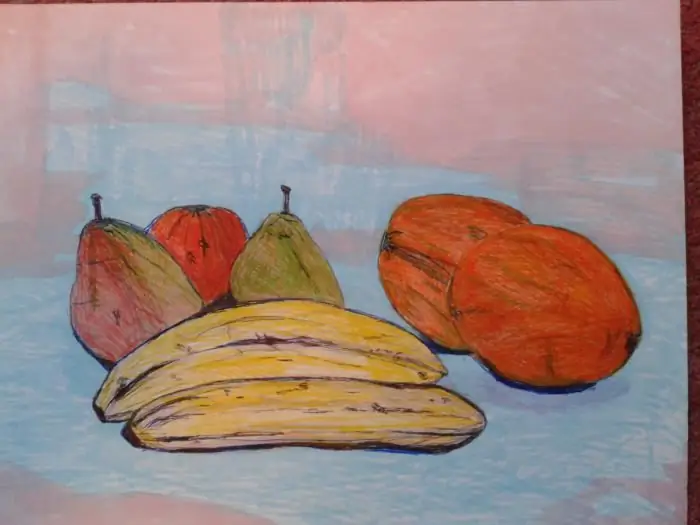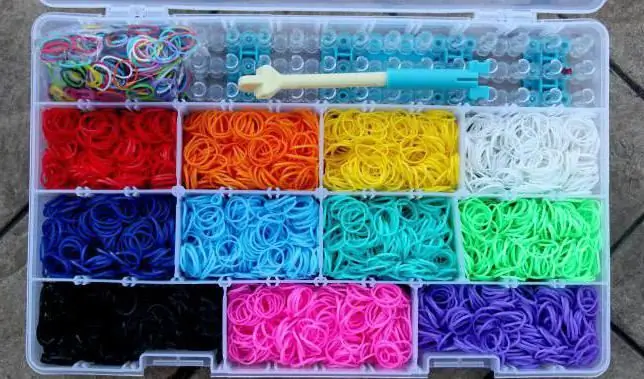
Inhaltsverzeichnis:
- Mit unseren eigenen Händen einen realistischen Apfel erschaffen
- Schritt-für-Schritt-Anleitung zum Erstellen eines Apfels
- Apfel fertig
- Gemüse und Obst häkeln. Schema und Beschreibung von Karotten
- Schritt-für-Schritt-Beschreibung des Arbeitsablaufs
- Möhren aufessen
- Wie man Kohl bindet? Ein weiteres gutes Schema im Sparschwein der Ideen
- Wir stricken Kohlblätter und stellen das Produkt zusammen
- Autor Sierra Becker [email protected].
- Public 2024-02-26 04:45.
- Zuletzt bearbeitet 2025-06-01 05:43.
Der Haken ist ein wunderbares Strickwerkzeug, mit dem Sie eine Vielzahl von Produkten herstellen können - Kleidungsstücke, Heimtextilien, Spielzeug, Innendekoration und sogar Lebensmittel. Wenn Sie Ihre Kreativität erweitern und lernen möchten, wie man naturgetreue Früchte strickt, ist dieser Artikel genau das Richtige für Sie. Darin werden wir uns die Technik des Häkelns von Gemüse und Obst ansehen. Schemata und Beschreibungen für sie werden klar und einfach sein, selbst unerfahrene Meister werden in der Lage sein, sie zu meistern. Lass uns gemeinsam "Lebensmittel" häkeln!

Mit unseren eigenen Händen einen realistischen Apfel erschaffen
Wir empfehlen Ihnen, Ihre Bekanntschaft mit der Technik des Häkelns von Obst und Gemüse zu beginnen, indem Sie einen köstlichen Apfel herstellen. Um zu arbeiten, müssen Sie einige Tools vorbereiten, nämlich:
- Haken Nummer 3,5;
- eine kleine Menge rotes und braunes Garn (Fadendichte - 250 g pro 100 m);
- Strickmarkierer;
- Nadel mit großem Auge;
- alle Füller (zum Beispiel syntepuh).
In der Beschreibung des Strickvorgangs eines Apfels verwenden wir einige Abkürzungen: RLS (einfaches Häkeln), SP (Verbindungsschlaufe), VP (Luftschlaufe), Abnahme (2 feste Häkeln mit einer gemeinsamen Spitze, gestrickt für die vorderen Halbmaschen der vorherigen Reihe).
Noch ein wichtiger Punkt: Am Ende jeder Reihe werden beim Stricken von Amigurumi-Produkten keine Verbindungsmaschen verwendet. Die Reihen werden spiralförmig gestrickt. Um Anfängern das Zählen zu erleichtern, empfehlen wir daher, am Anfang jeder Reihe Strickmarker zu verwenden.

Schritt-für-Schritt-Anleitung zum Erstellen eines Apfels
Wir nehmen einen roten Faden und machen daraus einen magischen Ring. In Reihe 1 stricken wir 6 fM. In Reihe 2 nehmen wir Erhöhungen vor. In allen Maschen der Basis stricken wir 2 fM, wir bekommen 12 Maschen. In Reihe 3 machen wir 1 fM in jeden Scheitelpunkt. Verwenden Sie in Reihe 4 das Muster (2 fM in der Schleife, 1 fM in der nächsten) 6 Mal. Wir bekommen 18 Schleifen.
Verwenden Sie in Reihe Nr. 5 das Schema (2 fM in einer Schleife, in den nächsten beiden - jeweils 1 fM) 6 Mal. Wir erh alten 24 Sp alten. In Reihe Nr. 6 6 Mal wiederholen (2 fM in einer Schleife, in den nächsten 3 - 1 fM je). Mit Additionen zählen wir 30 Sp alten. In Reihe 7 stricken wir 1 fM in jeden Scheitelpunkt. In Reihe Nr. 8 wiederholen wir das Schema 6 Mal (2 fM in einer Schleife, in den nächsten 4 - 1 fM jeweils). Wir prüfen uns selbst - es sollten 36 Takte werden.

Die Reihen 9 bis 12 werden mit festen Maschen gehäkelt, eine in jeder Schleife der Kette. In Zeile 13 beginnen wir mit der Abnahme. Wir wiederholen das Schema sechsmal (abnehmen, 1 fM in den nächsten 4 Schleifen). Wir bekommen 30 Sp alten. In Reihe 14 stricken wir 1 fM in alle Scheitelpunkte. In Reihe 15 6 Mal wiederholen (abnehmen, 1 fM in den nächsten 3 Schleifen). Wir zählen 24 Sp alten. In Zeile Nr. 16 machen wir eine Sp alte in jedem Scheitelpunkt.
In Reihe Nr. 17 verwenden wir das Muster 6 Mal (Abnehmen, 1 fM in den nächsten 2 Schleifen). Wir reduzieren die Anzahl der Sp alten in einer Reihe auf 18. In den Reihen Nr. 18 und Nr. 19 führen wir in jeder Schleife 1 RLS durch. In Reihe Nr. 20 wiederholen wir 6 Mal (Abnahme, 1 RLS in der nächsten Schleife. Wir erh alten 12 Sp alten. Wir füllen den Apfel mit Syntepuh durch das Loch. In Reihe Nr. 21 nehmen wir 6 Mal ab. Schneiden Sie den Faden ab und lassen Sie ihn ein langes Ende (30 cm) Unser Apfel ist fast fertig Jetzt wissen Sie, dass das Häkeln von Gemüse und Obst mit Mustern und einer guten Beschreibung zu einem einfachen und ziemlich schnellen Prozess wird.

Apfel fertig
Für die Herstellung des Griffs verwenden wir Strickfäden in einem braunen Farbton. Wir führen 7 VP und SP in der zweiten Schleife des Tools aus. Wir machen 5 weitere Joint Ventures. Wir schneiden den Faden ab und lassen ein langes Ende zurück. Wir befestigen, indem wir den Faden durch die letzte Schlaufe fädeln.
Wir nehmen eine Nadel mit einem großen Öhr und führen ein Stück Faden ein, das nach dem Stricken eines Apfels übrig geblieben ist. Nähen Sie das Loch an der Spitze der Frucht zu. Wir geben dem Apfel die richtige Form: Drücken Sie mit dem Finger auf die Spitze, führen Sie die Nadel nach unten, ziehen Sie den Faden in den Anfangsring undzurück an die Spitze. Wir wiederholen den Vorgang noch ein oder zwei Mal, bis eine realistische Form erreicht ist. Thread reparieren.
Es bleibt nur noch, den Stiel zu nähen, auch den Faden nach unten in den magischen Ring zu führen und die Nadel wieder nach oben zu führen. Wenn Sie den Vorgang wiederholen, erh alten Sie einen sauber genähten Stiel und „Kepalen“am unteren Rand. So einfach und unkompliziert lassen sich Gemüse und Obst häkeln. Das Apfelschema ist bequem und verständlich, verwenden Sie es bei Ihrer Arbeit. Viel Glück!
Gemüse und Obst häkeln. Schema und Beschreibung von Karotten
Um eine helle Karotte herzustellen, müssen Sie Baumwollgarn (Dichte 125 m pro 50 g) in zwei Farben vorbereiten - orange und grün, Haken Nr. 1, 75 oder Nr. 2, Füllstoff, Nadel, Stricken Markierungen.

Bei der Beschreibung des Strickvorgangs werden folgende Abkürzungen verwendet:
- СБН - feste Maschen;
- SP - Verbindungsschleife;
- Zunahme - 2 fM in 1 Schleife der Kette;
- Reduktion - 2 fM mit einer gemeinsamen Spitze, gestrickt für die vordere Halbschlaufe.
Schritt-für-Schritt-Beschreibung des Arbeitsablaufs
Nachdem wir das Notwendige vorbereitet haben, fangen wir an, Gemüse und Obst zu häkeln. Das Schema der Karotten ist wie folgt. Mit einem orangefarbenen Faden machen wir einen magischen Ring und 6 RLS. In Reihe 2 stricken wir Zunahmen in allen Maschen der Basis. In Zeile Nr. 3 verwenden wir das Schema (1 RLS, erhöhen) 6 Mal. Wir erh alten 18 Sp alten. In Reihe Nr. 4 stricken wir 6 Mal und wiederholen das Muster (Erhöhung, 1 fM in den nächsten 2 Maschen). Wir zählen 24 Sp alten.
Legen Sie das Werkstück beiseite. Wir nehmen einen grünen Faden und machen 10 VP aus. Ab der zweiten Schleife stricken wir 9 fM. Wir fixieren den Faden, schneiden ihn ab und hinterlassen eine lange Spitze. Wir nähen das Blatt an den orangefarbenen Rohling in der Mitte, führen die Fäden nach unten und binden sie zu einem Knoten. In Analogie dazu machen wir ein paar mehr dieser Blätter (6-8) und kehren zur Herstellung von Karotten zurück.
In den Reihen Nr. 5 - Nr. 9 führen wir 1 sc in jeder Schleife der Kette aus. In Reihe 9 stricken wir 1 Abnahme und 22 fM. Wir erh alten 23 Sp alten. In Reihe 10 häkeln Sie 1 fM in jede M. In Reihe 11 stricken wir 12 fM, 1 Abnahme und 9 weitere fM. In den Reihen Nr. 12 und Nr. 13 machen wir an jedem Scheitelpunkt 1 RLS. In Reihe 14 stricken wir 3 fM, 1 Abnahme und weitere 17 fM. Wir füllen das Teil mit Sintepuh und stricken weiter.
Möhren aufessen
In den Reihen Nr. 15 und Nr. 16 machen wir 1 fM in alle Ecken. In Reihe Nr. 17 stricken wir 13 fM, 1 Abnahme und 6 fM. Wir zählen 20 Sp alten. In den Reihen Nr. 18 und Nr. 19 stricken wir 1 fM in jeden Scheitelpunkt. In Reihe 20 machen wir 6 fM, 1 Abnahme, 12 fM. In den Reihen Nr. 21 und Nr. 22 stricken wir 1 fM in jede Masche.

In Reihe 23 machen wir 15 fM, 1 Abnahme, 2 fM. Wir überprüfen uns selbst - Sie sollten 18 Schleifen erh alten. In den Reihen Nr. 24 und Nr. 25 stricken wir 1 fM in alle Scheitelpunkte. In Reihe Nr. 26 machen wir 9 fM, 1 Abnahme und 7 fM. Wir zählen 17 Schleifen. Füge dem Leerzeichen etwas mehr Füllmaterial hinzu.
In den Reihen Nr. 27 und Nr. 28 stricken wir 1 fM in alle Maschen. In Reihe 29 machen wir eine Abnahme und 15 fM. Wir zählen 16 Schleifen. In Reihe 30 machen wir 1 sc in allen Schleifen. In Reihe Nr. 31 führen wir 11 fM, Abnahme und 3 fM aus. Karotten sind fast fertig.
In Reihe 32 stricken wir 1 fM in alle Maschen. In Reihe 33 machen wir 3 fM,abnehmen und 10 sc. In Reihe 34 stricken wir 1 fM in alle Maschen. In Reihe 35 führen wir 7 fM, Abnahme und 5 fM aus. Wir zählen 13 Schleifen. In Reihe 36 machen wir eine Abnahme und 11 fM. In Zeile Nr. 37 verwenden wir das Schema (1 RLS - Abnahme) 4 Mal. Wir bekommen 8 Schleifen. Wiederholen Sie in Reihe Nr. 38 zweimal (1 fM in den nächsten beiden Schleifen - Abnahme). Fügen Sie die erforderliche Menge Füllstoff hinzu. Sie können den Faden abschneiden und vernähen. Herzlichen Glückwunsch, unsere bunte Karotte ist fertig! Sehen Sie, wie einfach und unkompliziert gehäkeltes Gemüse und Obst entstehen. Denken Sie an Strickmuster und stellen Sie sicher, dass Sie sie in Ihrer Arbeit verwenden. Kreativer Erfolg für Sie!
Wie man Kohl bindet? Ein weiteres gutes Schema im Sparschwein der Ideen
Zum Häkeln von Gemüse (Kohl) verwenden wir grünes Garn (250 m dick pro 100 g) und eine 3 mm Nadel. Sie benötigen außerdem Füllmaterial, Stifte, eine Schere und eine Nadel mit großem Öhr.

Zuerst machen wir den "Kern" des Kohls. Wir machen einen magischen Ring und 6 sc hinein. In Reihe 2 stricken wir an jedem Scheitelpunkt Zunahmen. In Zeile Nr. 3 verwenden wir das Schema 6 Mal (1 RLS - Erhöhung). Wiederholen Sie in Reihe Nr. 4 das Muster (1 fM in 2 Schleifen, Zunahme) 6 Mal. Wir zählen 24 Schleifen. In Reihe Nr. 5 6 Mal wiederholen (1 fM in 3 Schleifen, Zunahme). Wir bekommen 30 Schleifen. In den Reihen Nr. 6 - Nr. 10 stricken wir 1 fM in jeden Scheitelpunkt.
In Reihe Nr. 11 verwenden wir das Schema 6 Mal (1 fM in 3 Schleifen, abnehmen). Wir erh alten 24 Schleifen. Wiederholen Sie in Reihe 12 6 Mal (1 fM in 2 Schleifen, abnehmen). Wir zählen 18 Schleifen. Wir beginnen unser Werkstück mit Füllstoff. Wiederholen Sie in Reihe 13 6 Mal (1 fM, abnehmen). In Reihe Nummer 146 mal reduzieren. Schneiden Sie den Faden ab und ziehen Sie das Ende durch die Endschlaufe. Nähe das Loch zu und verstecke die Enden.
Wir stricken Kohlblätter und stellen das Produkt zusammen
Wir machen kleine Kohlblätter nach folgendem Schema. In Reihe 1 machen wir einen magischen Ring und 6 fM. In Reihe Nr. 2 führen wir 3 VP, 1 С1Н (Sp alte mit 1 Häkelarbeit) in derselben Schleife aus. Dann 5 mal wiederholen (1 C1H, Steigerung). Wir schließen das Joint Venture an die Spitze der Kette des Anfangs. In Reihe Nr. 3 machen wir 3 VP, 1 С1Н in derselben Schleife, wiederholen 11 Mal (1 С1Н, erhöhen). Faden abschneiden und vernähen. Analog stricken wir 7 weitere solcher Blätter.

Große Blätter werden analog zu kleinen ausgeführt, aber wir fügen 1 weitere Reihe hinzu. In Reihe Nr. 4 stricken wir 3 VP, in der nächsten Schleife machen wir (1 С1Н, Zunahme), dann verwenden wir das Muster 11 Mal (1 С1Н in den nächsten 2 Schleifen, Zunahme). Wir erh alten 36 Schleifen. Bereit. Wir stricken noch ein paar große Blätter und fahren mit der Montage fort. Zuerst nähen wir kleine und dann große Blätter an den Kern. Unser Kohl ist also fertig! Es ist sehr realistisch und schön geworden. Wir hoffen, Sie fanden die in diesem Artikel vorgestellten Gemüse- und Obst-Häkelanleitungen hilfreich.
Empfohlen:
Kinderhandwerk aus Gemüse. Basteln aus Gemüse und Obst im Kindergarten

Wenn der Lehrer darum gebeten hat, Kinderhandwerk aus Gemüse und Obst in den Kindergarten zu bringen, können Sie es schnell zu Hause aus dem verfügbaren Material herstellen. Ein Apfel lässt sich leicht in eine lustige Figur verwandeln, eine Karotte in eine Raupe und eine Paprika in einen Piraten
Herbstkompositionen aus Gemüse und Obst. Wir schaffen Meisterwerke aus den Gaben der Natur

Herbst ist Erntezeit. Lange Zeit war es zu dieser Jahreszeit üblich, Jahrmärkte zu veranst alten. Herbstkompositionen aus Gemüse werden zu einem wichtigen Bestandteil solcher Verkäufe. Sie können die Aufmerksamkeit der Betrachter auf das Produkt lenken und als eine Art Werbung fungieren. Herbstkompositionen aus Gemüse und Blumen mit eigenen Händen zu formen, ist eine ganze Kunst, die bis heute überlebt hat
DIY-Zusammensetzung von Obst und Gemüse: Schritt-für-Schritt-Anleitung mit Fotos

Gemüse und Obst können nicht nur als Lebensmittel verwendet werden. Dies ist ein großartiges Material für verschiedene Bastelarbeiten. Jede handgemachte Komposition aus Obst und Gemüse kann Ihren Feiertagstisch schmücken oder Ihre täglichen Mahlzeiten abwechslungsreicher gest alten
Gestricktes Gemüse und Obst: ein Foto mit Beschreibung

Vor nicht allzu langer Zeit gewann ein neuer Trend an Popularität. Es wurde von kreativen Nadelfrauen eingeführt. Es besteht darin, Ihr Zuhause mit gestricktem Gemüse und Obst zu dekorieren. Aus diesem Grund haben wir für die Leser eine Schritt-für-Schritt-Meisterklasse vorbereitet. Dank ihm wird es nicht schwierig sein, die Idee in die Realität umzusetzen
Wie man Gemüse und Obst aus Gummibändern webt: eine detaillierte Beschreibung des Webens mit einer Schleuder

Weben nimmt eine besondere Nische in der Handarbeit ein: Obst und Gemüse aus Gummibändern auf einer Schleuder. Wie webt man eine Banane, Karotte und Tomate aus Gummibändern?
